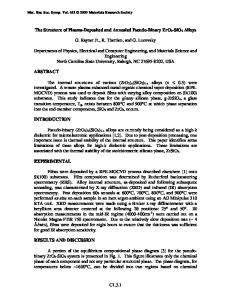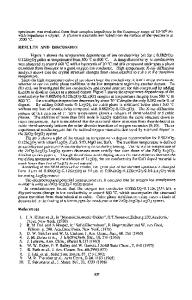Crystallization and Phase Transformation of ZrO 2 -SiO 2 Gels
- PDF / 431,037 Bytes
- 6 Pages / 420.48 x 639 pts Page_size
- 68 Downloads / 416 Views
CRYSTALLIZATION AND PHASE TRANSFORMATION OF ZrO 2-SiO
2
GELS
XIAOMING LI and P.F. JOHNSON New York State College of Ceramics at Alfred University, Alfred, NY 14802 ABSTRACT Pure SiO 2 , ZrO 2 and SiO 2-ZrO 2 gels have been prepared by hydrolysis and gelation of tetraethylorthosilicate (TEOS) and zirconium acetate solution. The crystallization and phase transformation of Si0 2 and ZrO 2 in these gels have been followed up to 1450'C using differential thermal analysis (DTA), thermal gravimetric analysis (TGA) and X-ray diffraction analysis (XRD). The crystallization and phase transformation behavior of Si0 2 or ZrO 2 is quite different in different gel systems. It was found that in pure Si0 2 gel, the cristobalite phase was precipitated out at about 1000*C. In the pure ZrO 2 system, tetragonal (t-) phase zirconia was crystallized at about 430'C, t-ZrO 2 crystals grew three dimensionally and the activation energy for growth was calculated as about 365 kJmol-'. But in the SiO 2-ZrO 2 system, the presence of Zr0 2 suppressed the crystallization of Si0 2 , and Si0 2 increased the initial crystallization temperature and the stability of t-ZrO 2 . INTRODUCTION Zirconia-containing silicate glasses have attracted much attention because of their excellent resistance to alkali corrosion and their low thermal expansion. Much work has been done on ZrO 2 based glass-ceramics due to the potential for transformation toughening. Attempts to toughen silicate glass by introducing ZrO 2 have been reported recently and these attempts show potential for improving fracture toughness [1-3]. Very few studies have been conducted on Si0 2 -ZrO 2 binary glasses because these glasses are very difficult to prepare by conventional melting due to the very high melting temperature of the oxides. Recently, a low temperature synthesis method (the sol-gel process) has been proposed to prepare Si0 2 -ZrO 2 glasses with zirconia contents up to 60 mol% [4,5]. However, the role and the influence of Si0 2 and ZrO 2 on the crystallization and the consequent phase transformation behavior in these gels are still unclear. The crystallization behavior of silica and zirconia in the binary system and subsystems derived through sol-gel processes need more study. In the present paper, the crystallization and phase transformation in pure Si0 2 , pure Zr0 2 and Si0 2-ZrO2 gels have been studied and compared. EXPERIMENTAL Si(OC 2 Hs) 4 (TEOS) and zirconium acetate solution (22 wt.% ZrO 2 ), were used as precursor materials. The clear binary sol with the composition of 45 wt% ZrO 2 • 55 wt% Si0 2 was prepared using 2 steps. First, the TEOS, water, ethanol and HCl catalyst (in 1:1:4:0.1 mole ratio) were mixed by vigorously stirring at room temperature. The homogeneous solution was allowed to prehydrolyze for 1 hour at room temperature. Second, the zirconium acetate solution was added drop by drop into the prehydrolyzed silica alkoxide solution while continuously stirring. The resulting solution was then poured in a Teflon container and allowed to gel at room temperat
Data Loading...










